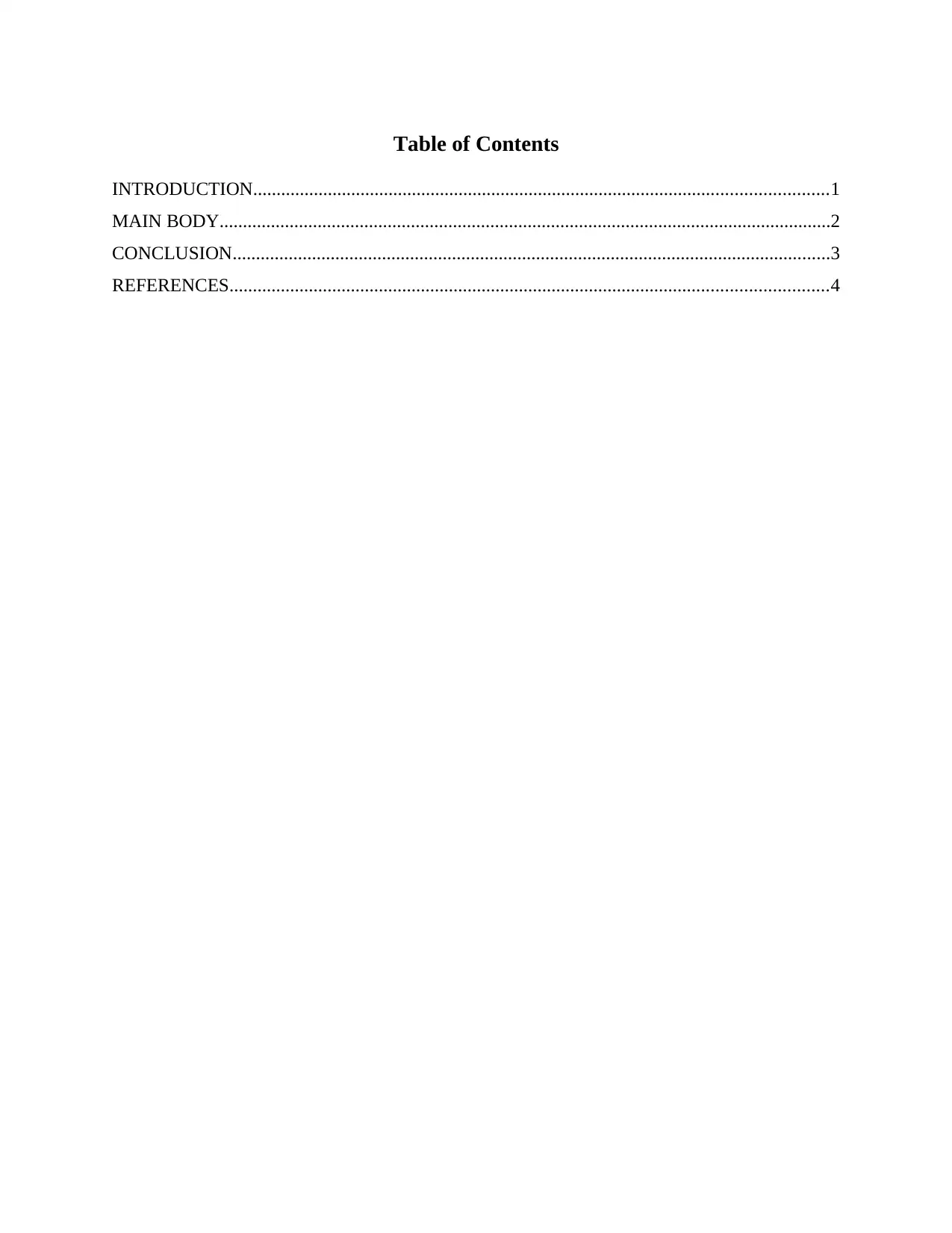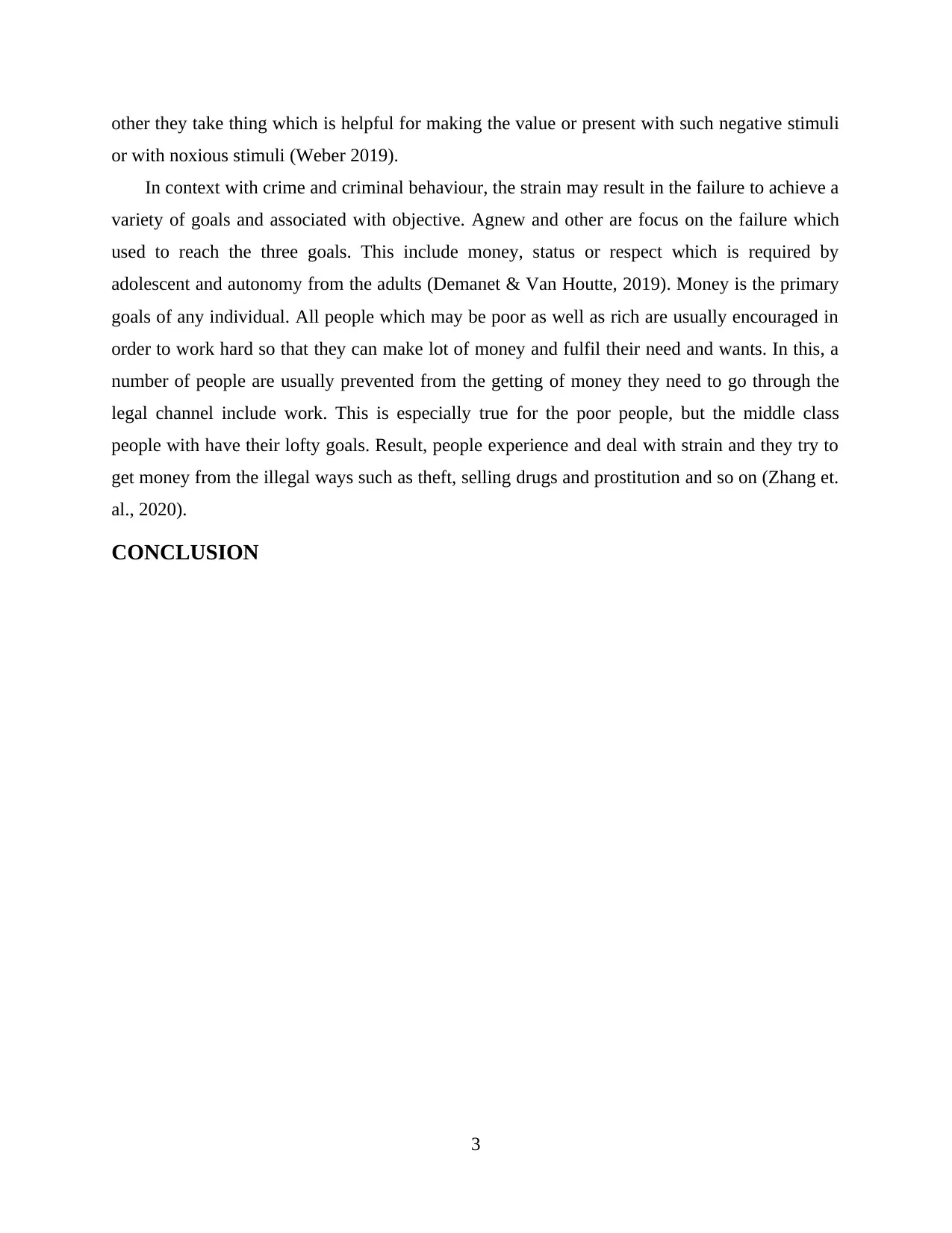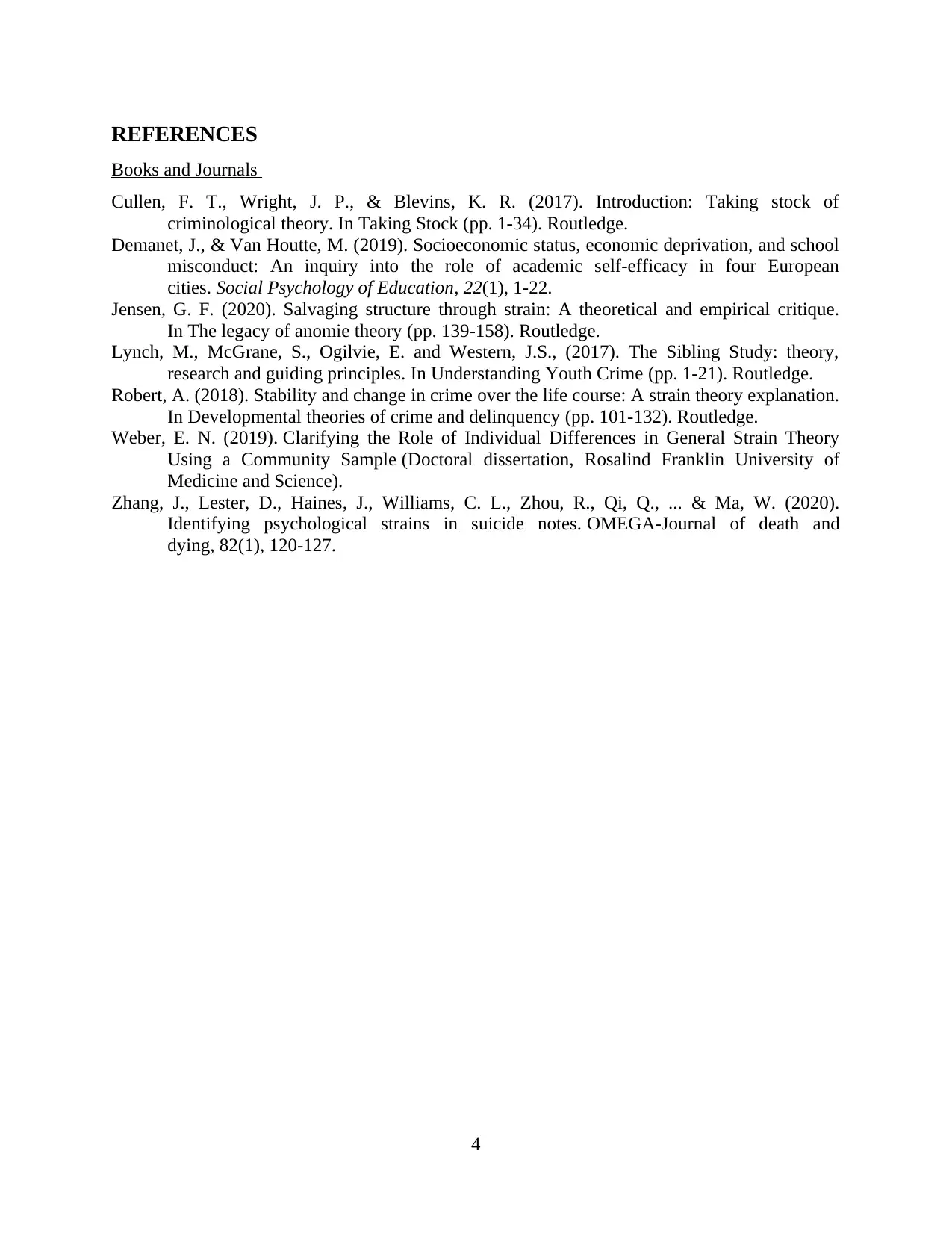Essay: Sociological Theories and Their Impact on Criminal Behavior
VerifiedAdded on 2023/06/18
|7
|1453
|426
Essay
AI Summary
This essay explores the relationship between sociological theories and criminal behavior, focusing on strain theory. It begins by defining sociological theory and its relevance to understanding why individuals engage in criminal activities due to inadequate socialization and failure to adhere to societal norms. The essay highlights strain theory, particularly the work of Robert K. Merton, which posits that social factors like lack of income and quality education can drive individuals to commit crimes. It discusses the strengths and weaknesses of strain theory, including its limitations in explaining middle-class delinquency. Furthermore, the essay examines Robert Agnew's general strain theory, which considers the role of emotions and a wider range of stressors in contributing to criminal behavior, such as the failure to achieve goals like money, status, and autonomy. The conclusion reinforces the idea that strain, arising from social and economic pressures, can lead individuals to engage in illegal activities as a means of achieving their desires.

Sociological theories
and criminal behaviour:
Essay
and criminal behaviour:
Essay
Paraphrase This Document
Need a fresh take? Get an instant paraphrase of this document with our AI Paraphraser

Table of Contents
INTRODUCTION...........................................................................................................................1
MAIN BODY...................................................................................................................................2
CONCLUSION................................................................................................................................3
REFERENCES................................................................................................................................4
INTRODUCTION...........................................................................................................................1
MAIN BODY...................................................................................................................................2
CONCLUSION................................................................................................................................3
REFERENCES................................................................................................................................4

INTRODUCTION
The sociological theory is defined as the set of new ideas and innovation which is based on the
explanation and elaboration for the human society. Moreover, these theories are selective in
nature which is based on various terms of their priorities and basic perspective which is
associated with the perception. As per this, the major outcome which help to provide a particular
and partial view of the reality. In the context with the sociological theory and criminal behaviour,
it is evaluated that the criminal behaviour is usually occur when the individual is not properly
socialised and they can create hindrance in follow the rules, laws and more which has been
established by the society in order to maintain the ethical social group and community. To
understand the criminal behaviour, the strain theory is chosen in order to know the effect and
concept of strain regards with crime and criminal behaviour, the major motive is to choose this
theory because the strain theory is related with the social aspect that propose pressure derived
from the social factor which majorly include lack of income or lack of quality education that
drives individual in order to commit crime.
This theory has predominant ideas which is helpful to play role in understanding the core
concepts that social factor is also responsible for taking participation in crime. The evidence
which show some strong evidence which is majorly located within such a way is provide a
thoughtful view regards with strain theory. Moreover, the discussion is being taken while taking
the contrast of crime and criminal behaviour and measured by using the approach of strain
theory. This theory has proper strength and weakness that show evidence that strain theory
defines the concept of crime and criminal behaviour in appropriate way and also lack of
approach as evidence is also recognise with theory which act as weakness. However, the strain
theory is completely based on the aspect of sociology which create pressure from the social
factor which have lack of income or lack of quality, this act as a catalyst for the individual to
commit crime to gain some social improvement. With the help of example, if any individual has
facing the issue with low income and lack of education and they have their set of need and want
then in order to fulfil such need individual commit minor crime and after that it turn with major
crime.
1
The sociological theory is defined as the set of new ideas and innovation which is based on the
explanation and elaboration for the human society. Moreover, these theories are selective in
nature which is based on various terms of their priorities and basic perspective which is
associated with the perception. As per this, the major outcome which help to provide a particular
and partial view of the reality. In the context with the sociological theory and criminal behaviour,
it is evaluated that the criminal behaviour is usually occur when the individual is not properly
socialised and they can create hindrance in follow the rules, laws and more which has been
established by the society in order to maintain the ethical social group and community. To
understand the criminal behaviour, the strain theory is chosen in order to know the effect and
concept of strain regards with crime and criminal behaviour, the major motive is to choose this
theory because the strain theory is related with the social aspect that propose pressure derived
from the social factor which majorly include lack of income or lack of quality education that
drives individual in order to commit crime.
This theory has predominant ideas which is helpful to play role in understanding the core
concepts that social factor is also responsible for taking participation in crime. The evidence
which show some strong evidence which is majorly located within such a way is provide a
thoughtful view regards with strain theory. Moreover, the discussion is being taken while taking
the contrast of crime and criminal behaviour and measured by using the approach of strain
theory. This theory has proper strength and weakness that show evidence that strain theory
defines the concept of crime and criminal behaviour in appropriate way and also lack of
approach as evidence is also recognise with theory which act as weakness. However, the strain
theory is completely based on the aspect of sociology which create pressure from the social
factor which have lack of income or lack of quality, this act as a catalyst for the individual to
commit crime to gain some social improvement. With the help of example, if any individual has
facing the issue with low income and lack of education and they have their set of need and want
then in order to fulfil such need individual commit minor crime and after that it turn with major
crime.
1
⊘ This is a preview!⊘
Do you want full access?
Subscribe today to unlock all pages.

Trusted by 1+ million students worldwide

MAIN BODY
As per the beginning, it is defined that the strain theory is major concept related with the
sociology which is propose in such a view aspect that based on the social factor which based on
the lack of income or the lack quality education, in this, they drive and act as trigger unit to
commit the crime. Moreover, there are various ideas which is underlying and provide
information that it is introduced by American sociologist Robert K. Merton who work on the
subject which is transform especially influential in the 1950. There is other researcher who have
similar ideas, including American criminologist which have Albert Cohen and another
sociologist Richard Cloward and Lloyd Ohlin (Lynch, McGrane, Ogilvie 2017).
Classic strain theories which is major focused on the disadvantage which is based on group
with a common inspiration for example, it is based on realisation and the major inability which
help to achieve the goals and objective which is considered with a help to driving factor which is
associated with the committing of crime. Individual whose income place in such a way which
help to develop poverty threshold. For the clear understanding, they gone through some
realisation which is based on common factor which is socially ambition through the aspect of
legal mean and they force to do unethical behaviour to achieve their goals (Jensen 2020). The
major weakness which is analysed with the strain theory is that they include inadequate
explanation for the middle class which is based on delinquency and inconsistencies between the
aspiration which is based on life and expectation which is needed by person to achieve their aim
and fulfil their dream as a want. However, there is various elements which help to show the
general strain theory which include the consideration for the role of emotion in such a way which
help to derived the crime and their consideration of the wide range source which create pressure
on the societal level which may cause a catalyst for the individual to commit crime (Robert
2018).
There is recent view or the version of strain theory which is proposed by Robert Agnew
1992, in which the general strain theory is taken. Moreover, the Agnew theory help to draw some
of the aspect which is based on heavily on previous version that associated with version of strain
theory. However, the Agnew that point to certain type of strain which is not considered in the
previous version which help to provide a fuller discussion in such condition which create most
probable situation of committing crime. In this, there are two type of strain which is categories in
order to contribute to crime (Cullen 2017). They usually prevent from achieving the goals and
2
As per the beginning, it is defined that the strain theory is major concept related with the
sociology which is propose in such a view aspect that based on the social factor which based on
the lack of income or the lack quality education, in this, they drive and act as trigger unit to
commit the crime. Moreover, there are various ideas which is underlying and provide
information that it is introduced by American sociologist Robert K. Merton who work on the
subject which is transform especially influential in the 1950. There is other researcher who have
similar ideas, including American criminologist which have Albert Cohen and another
sociologist Richard Cloward and Lloyd Ohlin (Lynch, McGrane, Ogilvie 2017).
Classic strain theories which is major focused on the disadvantage which is based on group
with a common inspiration for example, it is based on realisation and the major inability which
help to achieve the goals and objective which is considered with a help to driving factor which is
associated with the committing of crime. Individual whose income place in such a way which
help to develop poverty threshold. For the clear understanding, they gone through some
realisation which is based on common factor which is socially ambition through the aspect of
legal mean and they force to do unethical behaviour to achieve their goals (Jensen 2020). The
major weakness which is analysed with the strain theory is that they include inadequate
explanation for the middle class which is based on delinquency and inconsistencies between the
aspiration which is based on life and expectation which is needed by person to achieve their aim
and fulfil their dream as a want. However, there is various elements which help to show the
general strain theory which include the consideration for the role of emotion in such a way which
help to derived the crime and their consideration of the wide range source which create pressure
on the societal level which may cause a catalyst for the individual to commit crime (Robert
2018).
There is recent view or the version of strain theory which is proposed by Robert Agnew
1992, in which the general strain theory is taken. Moreover, the Agnew theory help to draw some
of the aspect which is based on heavily on previous version that associated with version of strain
theory. However, the Agnew that point to certain type of strain which is not considered in the
previous version which help to provide a fuller discussion in such condition which create most
probable situation of committing crime. In this, there are two type of strain which is categories in
order to contribute to crime (Cullen 2017). They usually prevent from achieving the goals and
2
Paraphrase This Document
Need a fresh take? Get an instant paraphrase of this document with our AI Paraphraser

other they take thing which is helpful for making the value or present with such negative stimuli
or with noxious stimuli (Weber 2019).
In context with crime and criminal behaviour, the strain may result in the failure to achieve a
variety of goals and associated with objective. Agnew and other are focus on the failure which
used to reach the three goals. This include money, status or respect which is required by
adolescent and autonomy from the adults (Demanet & Van Houtte, 2019). Money is the primary
goals of any individual. All people which may be poor as well as rich are usually encouraged in
order to work hard so that they can make lot of money and fulfil their need and wants. In this, a
number of people are usually prevented from the getting of money they need to go through the
legal channel include work. This is especially true for the poor people, but the middle class
people with have their lofty goals. Result, people experience and deal with strain and they try to
get money from the illegal ways such as theft, selling drugs and prostitution and so on (Zhang et.
al., 2020).
CONCLUSION
3
or with noxious stimuli (Weber 2019).
In context with crime and criminal behaviour, the strain may result in the failure to achieve a
variety of goals and associated with objective. Agnew and other are focus on the failure which
used to reach the three goals. This include money, status or respect which is required by
adolescent and autonomy from the adults (Demanet & Van Houtte, 2019). Money is the primary
goals of any individual. All people which may be poor as well as rich are usually encouraged in
order to work hard so that they can make lot of money and fulfil their need and wants. In this, a
number of people are usually prevented from the getting of money they need to go through the
legal channel include work. This is especially true for the poor people, but the middle class
people with have their lofty goals. Result, people experience and deal with strain and they try to
get money from the illegal ways such as theft, selling drugs and prostitution and so on (Zhang et.
al., 2020).
CONCLUSION
3

REFERENCES
Books and Journals
Cullen, F. T., Wright, J. P., & Blevins, K. R. (2017). Introduction: Taking stock of
criminological theory. In Taking Stock (pp. 1-34). Routledge.
Demanet, J., & Van Houtte, M. (2019). Socioeconomic status, economic deprivation, and school
misconduct: An inquiry into the role of academic self-efficacy in four European
cities. Social Psychology of Education, 22(1), 1-22.
Jensen, G. F. (2020). Salvaging structure through strain: A theoretical and empirical critique.
In The legacy of anomie theory (pp. 139-158). Routledge.
Lynch, M., McGrane, S., Ogilvie, E. and Western, J.S., (2017). The Sibling Study: theory,
research and guiding principles. In Understanding Youth Crime (pp. 1-21). Routledge.
Robert, A. (2018). Stability and change in crime over the life course: A strain theory explanation.
In Developmental theories of crime and delinquency (pp. 101-132). Routledge.
Weber, E. N. (2019). Clarifying the Role of Individual Differences in General Strain Theory
Using a Community Sample (Doctoral dissertation, Rosalind Franklin University of
Medicine and Science).
Zhang, J., Lester, D., Haines, J., Williams, C. L., Zhou, R., Qi, Q., ... & Ma, W. (2020).
Identifying psychological strains in suicide notes. OMEGA-Journal of death and
dying, 82(1), 120-127.
4
Books and Journals
Cullen, F. T., Wright, J. P., & Blevins, K. R. (2017). Introduction: Taking stock of
criminological theory. In Taking Stock (pp. 1-34). Routledge.
Demanet, J., & Van Houtte, M. (2019). Socioeconomic status, economic deprivation, and school
misconduct: An inquiry into the role of academic self-efficacy in four European
cities. Social Psychology of Education, 22(1), 1-22.
Jensen, G. F. (2020). Salvaging structure through strain: A theoretical and empirical critique.
In The legacy of anomie theory (pp. 139-158). Routledge.
Lynch, M., McGrane, S., Ogilvie, E. and Western, J.S., (2017). The Sibling Study: theory,
research and guiding principles. In Understanding Youth Crime (pp. 1-21). Routledge.
Robert, A. (2018). Stability and change in crime over the life course: A strain theory explanation.
In Developmental theories of crime and delinquency (pp. 101-132). Routledge.
Weber, E. N. (2019). Clarifying the Role of Individual Differences in General Strain Theory
Using a Community Sample (Doctoral dissertation, Rosalind Franklin University of
Medicine and Science).
Zhang, J., Lester, D., Haines, J., Williams, C. L., Zhou, R., Qi, Q., ... & Ma, W. (2020).
Identifying psychological strains in suicide notes. OMEGA-Journal of death and
dying, 82(1), 120-127.
4
⊘ This is a preview!⊘
Do you want full access?
Subscribe today to unlock all pages.

Trusted by 1+ million students worldwide

5
1 out of 7
Related Documents
Your All-in-One AI-Powered Toolkit for Academic Success.
+13062052269
info@desklib.com
Available 24*7 on WhatsApp / Email
![[object Object]](/_next/static/media/star-bottom.7253800d.svg)
Unlock your academic potential
Copyright © 2020–2025 A2Z Services. All Rights Reserved. Developed and managed by ZUCOL.





